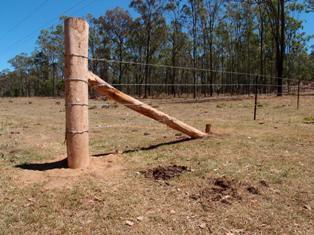While I like to use electric fencing for quick temporary fences, I do think its important to have a strong permanent fence for the boundary, around the house yard and, on a larger property, other fences to divide the property into paddocks.
This ensures that your cattle stay on your property even if your internal electric fence fails (for example, it the battery runs flat). For cattle, barbed wire is essential, at least four strands, if not five. Animal mesh can also be used, especially if you also keep goats or sheep, but be aware that cattle can climb over mesh by stepping on each section and gradually pulling it down (it sounds ridiculous, but I have seen this happen a couple of times), so a barbed wire top strand is needed to prevent fence climbing.
A fence typically consists of “end assemblies” at each corner, “strainer posts” every few hundred metres, and posts to support the wires every few metres. Fence posts can be made from either wood or steel. If you have access to trees, and the time and skills to cut posts, this is a very cheap way to make a fence. We usually don’t have time to make all the posts from wood, and use steel pickets (also called star pickets) in between wooden end assemblies.

End assemblies are used to keep the wire taught between corners of the paddock and strainer posts. They are also used either side of a gate. An end assembly must be constructed to brace the corner post or gate post so that it doesn’t move under the tension of the wire. The two most common methods are to use a post with a diagonal “stay” to brace the post, or to use two posts with a “cap rail” between them. We find that the stay is the simplest method and requires no holes to be drilled in the posts (a particularly powerful drill is needed for wooden posts). A steel end assembly can also be made using steel posts with a rail bolted or welded between them. We have also made hybrid systems with wooden posts and steel rails bolted between them. Pre-fabricated steel systems using either stays or cap rails can also be purchased.
To construct a new fence:
- Collect the required materials including end assemblies, strainer posts, posts and wire.
- Clear the proposed fence line of small trees and identify a straight line through larger trees.
- Install end assemblies and strainer posts along the proposed fence line.
- Run the top wire loosely between end assemblies and strainer posts.
- Use the first wire to locate all the intermediate posts and install these.
- Tension the first wire, and then run out and tension each remaining wire, completing a wire each side of the strainer post before moving to the next level, so that the tension is equal on each side.
- If using steel posts, tie the wire to each post using small lengths of wire (remember that you may need to undo these in future, so only use the minimum of twists to secure the wire). For wooden posts, the wire is fed through holes drilled in each post.
Fences require regular checking and re-straining as the wire stretches and posts move over time. Posts will eventually need to be replaced as they rust or are attacked by termites or rot. The wire can be joined when it breaks, but eventually it must be replaced also.
About the author
 |
Liz lives on eight acres in south east Queensland, Australia, with her husband Peter and two dogs. They have a passion for small-scale organic farming and producing and eating real food. They keep chickens, beef steers, two jersey cows and a big vegetable garden. Liz writes a blog about their farm to both inspire and help others who are interested in self-sufficiency, sustainability and permaculture. https://eight-acres.com.au |



